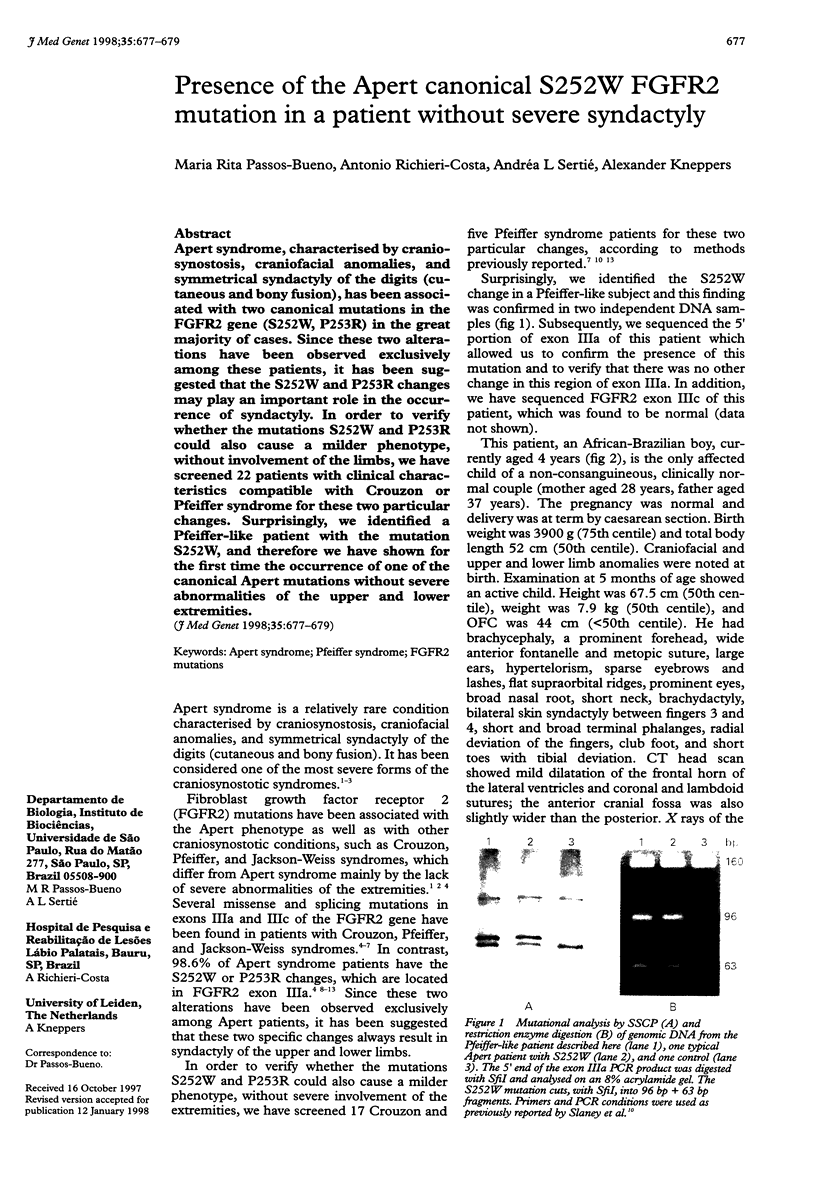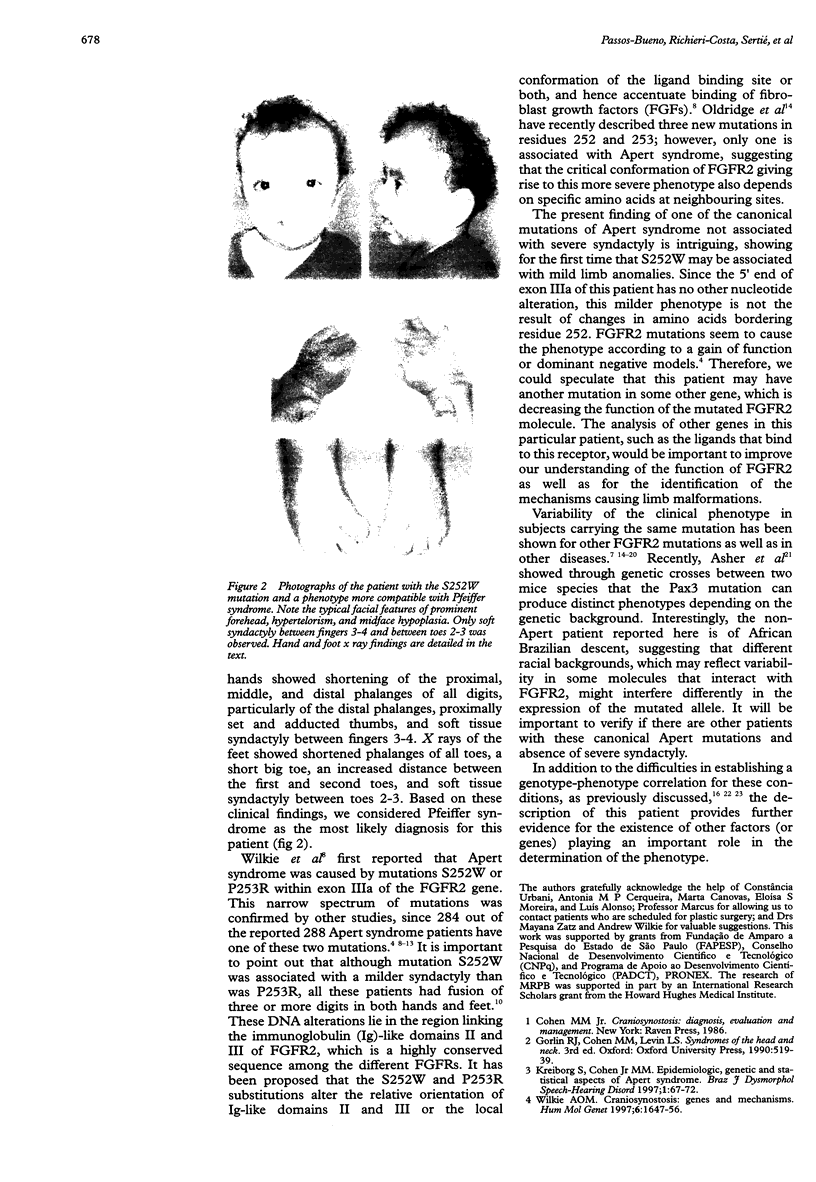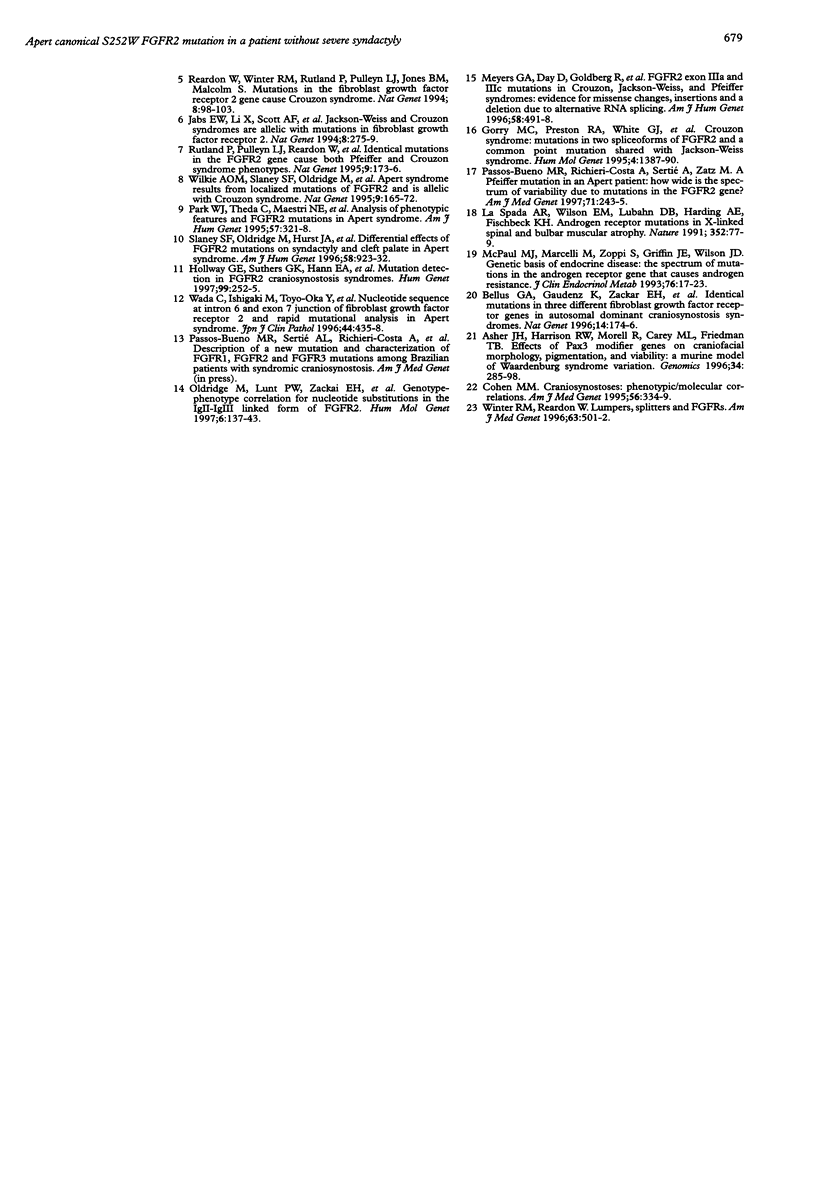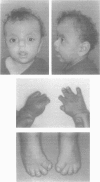Abstract
Apert syndrome, characterised by craniosynostosis, craniofacial anomalies, and symmetrical syndactyly of the digits (cutaneous and bony fusion), has been associated with two canonical mutations in the FGFR2 gene (S252W, P253R) in the great majority of cases. Since these two alterations have been observed exclusively among these patients, it has been suggested that the S252W and P253R changes may play an important role in the occurrence of syndactyly. In order to verify whether the mutations S252W and P253R could also cause a milder phenotype, without involvement of the limbs, we have screened 22 patients with clinical characteristics compatible with Crouzon or Pfeiffer syndrome for these two particular changes. Surprisingly, we identified a Pfeiffer-like patient with the mutation S252W, and therefore we have shown for the first time the occurrence of one of the canonical Apert mutations without severe abnormalities of the upper and lower extremities.
Full text
PDF


Images in this article
Selected References
These references are in PubMed. This may not be the complete list of references from this article.
- Asher J. H., Jr, Harrison R. W., Morell R., Carey M. L., Friedman T. B. Effects of Pax3 modifier genes on craniofacial morphology, pigmentation, and viability: a murine model of Waardenburg syndrome variation. Genomics. 1996 Jun 15;34(3):285–298. doi: 10.1006/geno.1996.0289. [DOI] [PubMed] [Google Scholar]
- Bellus G. A., Gaudenz K., Zackai E. H., Clarke L. A., Szabo J., Francomano C. A., Muenke M. Identical mutations in three different fibroblast growth factor receptor genes in autosomal dominant craniosynostosis syndromes. Nat Genet. 1996 Oct;14(2):174–176. doi: 10.1038/ng1096-174. [DOI] [PubMed] [Google Scholar]
- Cohen M. M., Jr Craniosynostoses: phenotypic/molecular correlations. Am J Med Genet. 1995 Apr 10;56(3):334–339. doi: 10.1002/ajmg.1320560327. [DOI] [PubMed] [Google Scholar]
- Gorry M. C., Preston R. A., White G. J., Zhang Y., Singhal V. K., Losken H. W., Parker M. G., Nwokoro N. A., Post J. C., Ehrlich G. D. Crouzon syndrome: mutations in two spliceoforms of FGFR2 and a common point mutation shared with Jackson-Weiss syndrome. Hum Mol Genet. 1995 Aug;4(8):1387–1390. doi: 10.1093/hmg/4.8.1387. [DOI] [PubMed] [Google Scholar]
- Jabs E. W., Li X., Scott A. F., Meyers G., Chen W., Eccles M., Mao J. I., Charnas L. R., Jackson C. E., Jaye M. Jackson-Weiss and Crouzon syndromes are allelic with mutations in fibroblast growth factor receptor 2. Nat Genet. 1994 Nov;8(3):275–279. doi: 10.1038/ng1194-275. [DOI] [PubMed] [Google Scholar]
- La Spada A. R., Wilson E. M., Lubahn D. B., Harding A. E., Fischbeck K. H. Androgen receptor gene mutations in X-linked spinal and bulbar muscular atrophy. Nature. 1991 Jul 4;352(6330):77–79. doi: 10.1038/352077a0. [DOI] [PubMed] [Google Scholar]
- McPhaul M. J., Marcelli M., Zoppi S., Griffin J. E., Wilson J. D. Genetic basis of endocrine disease. 4. The spectrum of mutations in the androgen receptor gene that causes androgen resistance. J Clin Endocrinol Metab. 1993 Jan;76(1):17–23. doi: 10.1210/jcem.76.1.8421085. [DOI] [PubMed] [Google Scholar]
- Meyers G. A., Day D., Goldberg R., Daentl D. L., Przylepa K. A., Abrams L. J., Graham J. M., Jr, Feingold M., Moeschler J. B., Rawnsley E. FGFR2 exon IIIa and IIIc mutations in Crouzon, Jackson-Weiss, and Pfeiffer syndromes: evidence for missense changes, insertions, and a deletion due to alternative RNA splicing. Am J Hum Genet. 1996 Mar;58(3):491–498. [PMC free article] [PubMed] [Google Scholar]
- Oldridge M., Lunt P. W., Zackai E. H., McDonald-McGinn D. M., Muenke M., Moloney D. M., Twigg S. R., Heath J. K., Howard T. D., Hoganson G. Genotype-phenotype correlation for nucleotide substitutions in the IgII-IgIII linker of FGFR2. Hum Mol Genet. 1997 Jan;6(1):137–143. doi: 10.1093/hmg/6.1.137. [DOI] [PubMed] [Google Scholar]
- Park W. J., Theda C., Maestri N. E., Meyers G. A., Fryburg J. S., Dufresne C., Cohen M. M., Jr, Jabs E. W. Analysis of phenotypic features and FGFR2 mutations in Apert syndrome. Am J Hum Genet. 1995 Aug;57(2):321–328. [PMC free article] [PubMed] [Google Scholar]
- Passos-Bueno M. R., Sertié A. L., Zatz M., Richieri-Costa A. Pfeiffer mutation in an Apert patient: how wide is the spectrum of variability due to mutations in the FGFR2 gene? Am J Med Genet. 1997 Aug 8;71(2):243–245. [PubMed] [Google Scholar]
- Reardon W., Winter R. M., Rutland P., Pulleyn L. J., Jones B. M., Malcolm S. Mutations in the fibroblast growth factor receptor 2 gene cause Crouzon syndrome. Nat Genet. 1994 Sep;8(1):98–103. doi: 10.1038/ng0994-98. [DOI] [PubMed] [Google Scholar]
- Rutland P., Pulleyn L. J., Reardon W., Baraitser M., Hayward R., Jones B., Malcolm S., Winter R. M., Oldridge M., Slaney S. F. Identical mutations in the FGFR2 gene cause both Pfeiffer and Crouzon syndrome phenotypes. Nat Genet. 1995 Feb;9(2):173–176. doi: 10.1038/ng0295-173. [DOI] [PubMed] [Google Scholar]
- Slaney S. F., Oldridge M., Hurst J. A., Moriss-Kay G. M., Hall C. M., Poole M. D., Wilkie A. O. Differential effects of FGFR2 mutations on syndactyly and cleft palate in Apert syndrome. Am J Hum Genet. 1996 May;58(5):923–932. [PMC free article] [PubMed] [Google Scholar]
- Wada C., Ishigaki M., Toyo-oka Y., Yamabe H., Ohnuki Y., Takada F., Yamazaki Y., Ohtani H. [Nucleotide sequences at intron 6 and exon 7 junction of fibroblast growth factor receptor 2 and rapid mutational analysis in Apert syndrome]. Rinsho Byori. 1996 May;44(5):435–438. [PubMed] [Google Scholar]
- Wilkie A. O. Craniosynostosis: genes and mechanisms. Hum Mol Genet. 1997;6(10):1647–1656. doi: 10.1093/hmg/6.10.1647. [DOI] [PubMed] [Google Scholar]
- Wilkie A. O., Slaney S. F., Oldridge M., Poole M. D., Ashworth G. J., Hockley A. D., Hayward R. D., David D. J., Pulleyn L. J., Rutland P. Apert syndrome results from localized mutations of FGFR2 and is allelic with Crouzon syndrome. Nat Genet. 1995 Feb;9(2):165–172. doi: 10.1038/ng0295-165. [DOI] [PubMed] [Google Scholar]
- Winter R. M., Reardon W. Lumpers, splitters, and FGFRs. Am J Med Genet. 1996 Jun 14;63(3):501–502. doi: 10.1002/ajmg.1320630302. [DOI] [PubMed] [Google Scholar]




